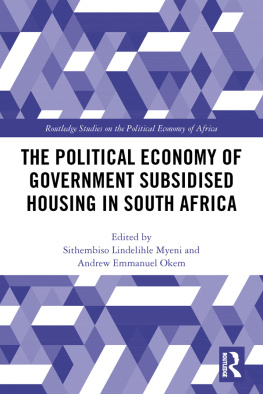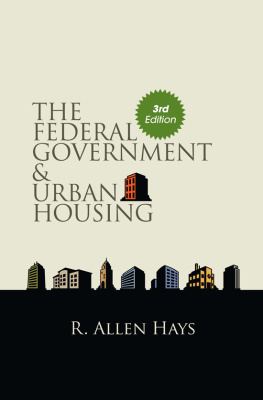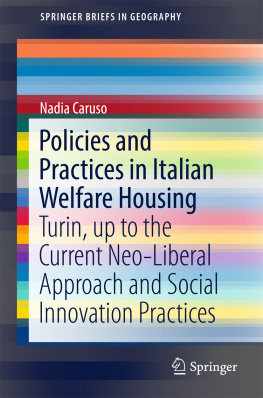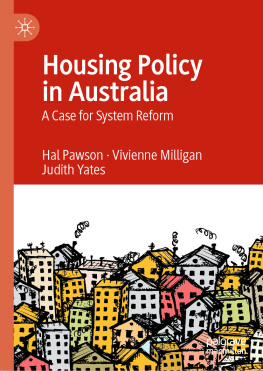THE DYNAMICS OF LOCAL HOUSING POLICY
To the memory of my mother, Claire Jacobs 1929-1981
First published 1999 by Ashgate Publishing
Reissued 2018 by Routledge
2 Park Square, Milton Park, Abingdon, Oxon, OX14 4RN
711 Third Avenue, New York, NY 10017, USA
Routledge is an imprint of the Taylor & Francis Group, an informa business
Copyright Keith Jacobs 1999
All rights reserved. No part of this book may be reprinted or reproduced or utilised in any form or by any electronic, mechanical, or other means, now known or hereafter invented, including photocopying and recording, or in any information storage or retrieval system, without permission in writing from the publishers.
Notice:
Product or corporate names may be trademarks or registered trademarks, and are used only for identification and explanation without intent to infringe.
Publishers Note
The publisher has gone to great lengths to ensure the quality ofthis reprint but points out that some imperfections in the original copies may be apparent.
Disclaimer
The publisher has made every effort to trace copyright holders and welcomes correspondence from those they have been unable to contact.
A Library of Congress record exists under LC control number: 99073167
ISBN 13: 978-1-138-34137-1 (hbk)
ISBN 13: 978-0-429-44016-8 (ebk)
This book is based on research carried out for a doctoral dissertation over a four year period between 1992 and 1996. My thanks are due, first to John Solomos for his conscientious supervision throughout the duration of the research. I am also grateful to colleagues at the University of Westminster: Judith Allen; James Barlow; Peter Harvie; Anna Haworth; Bill Smith-Bowers and Tony Manzi for providing helpful insights into various aspects of the research. Also Frauke Hansen for transcribing many of the interviews; Pat FitzGerald for her work in preparing the text for publication; Jon Walter and Mark Crick for permission to use some of their photographs.
I would also like to thank those councillors, officers and tenants from the London Borough of Hackney, the Government Office for London, the Housing Corporation and Hackney based housing associations who generously gave me their time and shared their expertise; especially Jenny Muir, Chris Patterson, Marion Robertson, David Thompson and Jerry White.
I would like to record my gratitude to David Hardie for his support and to the friends who helped by deeds during the final months of the writing up stage. In particular, Emma Peters for the many discussions on the theoretical approach and Daniel Pick who read the entire final draft and provided many valuable suggestions. Also Jane Fletcher, Jon Lunn and Melissa Parker for their advice on specific chapters. Whilst every effort has been made to check the accuracy of the research, undoubtedly errors remain, the responsibility for these is mine alone. Finally thanks to my family: Teresa for her support throughout, and my two daughters; Hannah and Sara.
This book investigates some emerging themes that have arisen from the establishment of The Comprehensive Estates Initiative (CEI) in 1992, a large- scale multi-agency housing renewal scheme established by Hackney Councils housing department. There are a number of reasons why I have chosen to focus on the CEI. Primarily, it encapsulates some of the most important developments taking place in housing policy. For example, it offers the opportunity to study the relationship between the public and private sector, tenant participation, innovation in housing management and collaboration with other social agencies, namely housing associations. The study of the CEI in Hackney can thus be viewed as a microcosm of many of the issues which form part of national policy discourse. Crucially, it provides a dynamic locale from which to construct a number of arguments and criticisms about contemporary policy. In particular it offers an opportunity to challenge some of the new orthodoxies that constitute substantive features of current housing practice.
In the specific context of local authority housing practice the CEI has already become a prototype for other local authorities housing renewal projects. For example, North Peckham estate in the London Borough of Southwark and Stonebridge Housing Action Trust in the London Borough of Brent closely mirror the CEI structure and partnership objectives. It is also clear from the guidelines published by the government on a National Strategy for Neighbourhood Renewal (Social Exclusion Unit, 1998) that similar models of organisation and funding will be required for future local authority led housing redevelopments. In addition, the CEI, encompassing as it does a wide range of current housing policies such as participation, partnership and management, enables a critical review of the general direction of such policies and their broader implications.
The research for the book was conducted between 1992 and 1996 and although the study is focused on a specific historical era, many of the issues remain pertinent. However, there have been some important developments since then. Following the Labour Partys General Election victory, compulsory competitive tendering is to be phased out by 2000 and superseded by Best Value. In addition through the establishment of the Social Exclusion Unit some of the long standing problems that exist on large council estates are now being addressed. The final chapter makes reference to the most significant of these changes.
The presentation of the book is thematic. ) explains the theoretical and methodological approach. It is proposed that the structuration theory advanced by Giddens (1984,1986,1987,1990) provides an appropriate framework to analyse the dynamics of policy processes and the connections between local activity and broad political change. The chapter also discusses the key epistemological assumption within the book, namely that reality is socially constructed and best understood as a system of meanings maintained through social action and discourse. It is argued that an appropriate approach for the study of localised housing renewal processes is to focus on examples of conflict taking place in the development and management of new policies. The chapter also includes a critical reflection on the applicability of these methods and the research problems encountered.
makes use of the theoretical and methodological discussions to explore, in detail the specific power relationships in which officers from the Government Office for London and Housing Corporation were involved. The chapter examines how central government was able to secure key housing policy objectives through its contacts with local authorities. It brings out the dynamic nature of central and local government relationships, demonstrating the need for research to examine institutional interaction, individual negotiation and social structure.
.
provides a summary of the significance of the turbulent period of the 1980s and its legacy for contemporary politics in Hackney. The chapter explores the ideological conflicts of the era including the influence of the New Left. It also examines the failures of policy intervention in respect of decentralisation initiatives, industrial-relations conflicts and the more recent problems that surfaced within the authority. It provides an historical context to policy issues, showing how recent housing policy cannot be, in analytical terms, separated from this recent past.











